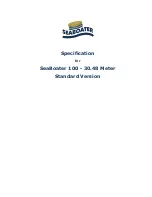
Check the Engine Oil Level
With the engine off, remove the engine oil dipstick from the top
side of the engine.
With a clean, dry cloth, wipe the dipstick free of residual oil and
reinsert it into the engine.
Withdraw the dipstick and note where the measurement reaches
on the dipstick.
If the engine oil level is at or below the fill line, add new oil as
Inspect the Sea Strainer
Raw water from the body of water is drawn into the boat as part
of the cooling system for the engine and drive train. Even with the
closed cooling systems, it is necessary to circulate additional water
as part of an effective cooling system. To protect the system, a sea
strainer is installed near the raw water intake, located at the transom
next to the steering tiller arm. The sea strainer serves the purpose
of keeping debris from entering the raw water-cooling system and
causing eventual engine failure. As with any kind of strainer, it is
necessary to regularly clean it so that water can flow unimpeded.
When operating the boat in water that is brackish or has a
noticeable degree of weeds and other flora, it may be necessary
to clean out the strainer in boats equipped with sea strainers even
during an outing. Pay close attention to the engine temperature, which
appears on the video screen. (See the
Dashes and Video Screens
sections of this manual for more information.) An overheating
engine is probably due to inadequate water flow.
Continuing to operate a boat that is
overheating the engine and drive train
will result in engine failure eventually.
Boat operators should routinely review the engine temperature
information provided on the video screen on the instrument
panel. Ignoring or failing to take proper steps to reduce the
engine temperature, resulting in
damage, is not covered under the
warranty.
Leave the engine off.
To inspect the sea strainer, open
the engine compartment. Note the sea
strainer’s appearance as shown in
the photo above. (If you cannot locate
the sea strainer, ask for assistance
from your authorized Malibu dealer.
This step is critical and cannot be
overlooked.
Open and lift the cover to expose the filter.
Remove the filter and examine for any debris that has
accumulated within it. When necessary, clean out the filter and then
reinstall it in the housing. Hand tighten the lid so that water will not
leak out and into the engine compartment.
If it is necessary to check the sea strainer during an outing, turn
off the engine first and then close the valve on the water pickup
feeding the sea strainer. Make sure you open the valve prior to
running the engine; otherwise, it will overheat. Whenever the engine
is running, water is being drawn in and you will not be able to inspect
the sea strainer.
Care and Maintenance—141
described in the
Oil Change information in
this section of the manual. Never reuse oil
or overfill as either can damage the engine,
and it is not covered under warranty. Use
only the oil specified for your installed
engine.
Check the Battery Holders and the Connections
Because batteries contain fluid that is caustic and potentially
dangerous to skin and body parts, boat operators need to ensure
that the batteries are securely in place. Also, if the connections are
loose, erroneous readings may be sent to the boat system, which
can cause running and functionality problems. To avoid becoming
stranded during an outing, it is important to have accurate voltage
readings throughout the time the boat is in use.
To check the batteries, be sure the engine is off.
Locate the batteries. While they will be in different places
depending on the boat model, usually they are found under a bow
seat. Check your
Quick Reference Guide in this manual to determine
the location.
• If the posts show signs of corrosion or other debris, remove the
battery and clean carefully. To do so, follow these steps:
• Turn the engine off, as well as any systems that are operating on
the boat.
• Make sure the battery switch is in the off position.
• Loosen and remove the negative (-) black terminal connection
first. If you are using a wrench for this process, be careful to
avoid touching the positive (+) red terminal connection as you
may receive an electrical shock as a result.
• Next, loosen and remove the positive (+) red terminal connection.
• Disconnect the hold-downs that are holding the battery in place.
• Remove the battery.
• Using a battery terminal cleaner, carefully clean the corrosion/
debris from the battery posts.
• Using a baking soda and water mix, clean the battery case, taking
care to avoid splashing any of the solution inside the battery
vents. Rinse with clear water, again, avoiding the vents.
Inside the battery is an electrolyte fluid
that allows the chemical reaction to
provide power. The fluid is comprised
of several components, one of which is sulfuric acid. As with
most acids, this is caustic and corrosive. If it comes in contact
with skin, immediately flush the area with copious amounts of
fresh, clean water. Follow up with medical assistance.
• A battery terminal brush may be necessary to remove corrosion
from the inside of the battery terminals. Use the same type of
baking soda and water mix and rinse with fresh water. Dry with a
clean rag.
• Check the box in which the battery is held to be certain that it is
not showing signs of corrosion or dirt. Clean, if necessary, as with
the above instructions for cleaning the battery. Be sure that the
holding box is dry prior to reinstalling the battery.
• Repeat with the steps with the second battery.
• After placing the battery back in the holding box, reconnect the
hold down. Then reconnect the positive (+) red battery cable
connection first. Follow with the negative (-) black battery cable
connection.
• Tighten both terminals and then coat with a thin covering of
















































